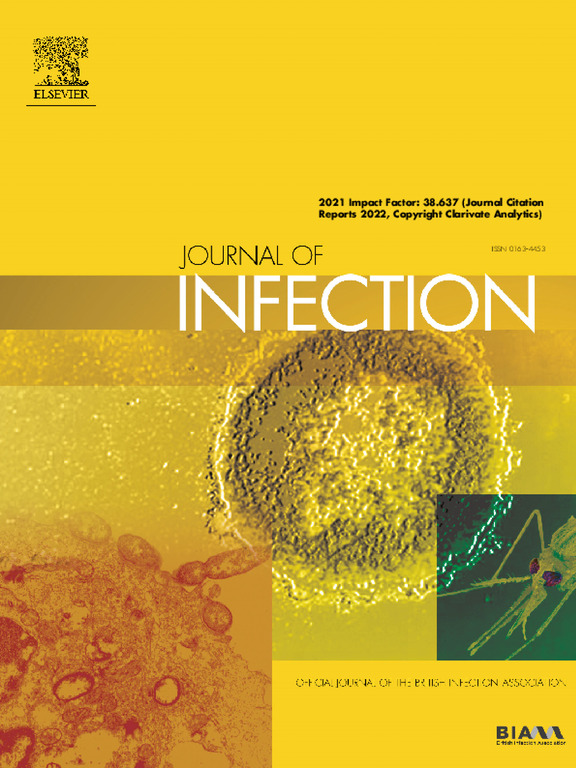Rad6和Bre1泛素连接酶负调控光假丝酵母的生物膜形成和毒力
IF 11.9
1区 医学
Q1 INFECTIOUS DISEASES
引用次数: 0
摘要
光念珠菌是一种机会性的人类真菌病原体,由于其固有的抗真菌耐药性和粘附在皮肤粘膜表面的能力而引起感染。表观遗传途径可能是耐药性发生的重要因素。我们之前的研究表明,H2B的去泛素化在C. glabrata氧化应激耐受和生物膜形成中起重要作用,受Ubp8、Sgf11、Sgf73和Sus1组成的模块调控。然而,Rad6和Bre1连接酶在调节H2B泛素化中的作用尚不清楚。方法通过产生Rad6、Bre1和Rad6 Bre1缺失突变体,对其功能进行表征。我们分析了小鼠全身念珠菌病模型的生物膜形成、关键粘附素(EPA1、EPA6、EPA20)和蛋白酶(YPS4)的基因表达、抗真菌药物敏感性、应激反应和毒力。结果RAD6和BRE1的缺失导致生物膜形成增强,与关键黏附素基因和蛋白酶基因YPS4的上调有关。突变体表现出不同的抗真菌药物敏感性模式:rad6和rad6 bre1突变体对唑类药物的敏感性增加,而bre1突变体在固体YPD琼脂板中对唑类药物的抗性增强,但在液体RPMI培养基中无显著差异。所有突变体都表现出对棘白菌素和两性霉素B的抗性降低,与麦角甾醇生物合成基因(ERG11)和葡聚糖合成酶基因(FKS1, FKS2)的表达改变有关。尽管抗氧化基因(SOD1, GPX2, CTA1)的基础表达升高,但突变体对氧化和细胞壁胁迫的抗性降低。在小鼠全身性念珠菌病模型中,与野生型相比,rad6和bre1突变体均表现出增强的毒力。结论RAD6和Bre1是光棘球霉生物膜形成、粘附及其相关基因表达的负调控因子,而RAD6缺失可抑制巨噬细胞ROS的产生,提高真菌存活率。在rad6和bre1突变体中观察到的毒性增强主要归因于生物膜形成增加、粘附能力增强和巨噬细胞免疫逃避的综合作用。本文章由计算机程序翻译,如有差异,请以英文原文为准。
Rad6 and Bre1 ubiquitin ligase negatively regulate biofilm formation and virulence in Candida glabrata
Background
Candida glabrata is an opportunistic human fungal pathogen causing infections due to its innate antifungal drug resistance and ability to adhere to mucocutaneous surfaces. Epigenetic pathways may be important factors in the development of drug resistance. Our previous studies showed that deubiquitination of H2B, regulated by a module comprised of Ubp8, Sgf11, Sgf73, and Sus1, plays important roles in oxidative stress tolerance and biofilm formation of C. glabrata. However, the roles of the Rad6 and Bre1 ligase in regulating the ubiquitination of H2B in C. glabrata remain unclear.
Methods
We characterized the functions of Rad6 and Bre1 in C. glabrata by generating deletion mutants (rad6, bre1, and rad6 bre1). We analyzed biofilm formation, gene expression of key adhesins (EPA1, EPA6, EPA20) and protease (YPS4), antifungal drug susceptibility, stress responses, and virulence in a murine model of systemic candidiasis.
Results
Deletion of RAD6 and BRE1 resulted in enhanced biofilm formation, correlating with upregulation of key adhesin genes and the protease gene YPS4. The mutants showed distinct patterns of antifungal drug susceptibility: rad6 and rad6 bre1 mutants exhibited increased sensitivity to azoles, while bre1 mutant showed enhanced resistance to azoles in solid YPD agar plates but no significant difference in liquid RPMI medium. All mutants demonstrated decreased resistance to echinocandins and amphotericin B, associated with altered expression of ergosterol biosynthesis genes (ERG11) and glucan synthase genes (FKS1, FKS2). The mutants also displayed decreased resistance to oxidative and cell wall stresses despite elevated basal expression of antioxidant genes (SOD1, GPX2, CTA1). In a murine model of systemic candidiasis, both rad6 and bre1 mutants exhibited enhanced virulence compared to the wild type.
Conclusion
Rad6 and Bre1 in C. glabrata function as negative regulators of biofilm formation and adhesion, and their related-genes expression, while RAD6 deletion also suppresses macrophage ROS production and enhances fungal survival. The enhanced virulence observed in the rad6 and bre1 mutants is primarily attributed to these combined effects of increased biofilm formation, enhanced adhesion capability, and macrophage immune evasion.
求助全文
通过发布文献求助,成功后即可免费获取论文全文。
去求助
来源期刊

Journal of Infection
医学-传染病学
CiteScore
45.90
自引率
3.20%
发文量
475
审稿时长
16 days
期刊介绍:
The Journal of Infection publishes original papers on all aspects of infection - clinical, microbiological and epidemiological. The Journal seeks to bring together knowledge from all specialties involved in infection research and clinical practice, and present the best work in the ever-changing field of infection.
Each issue brings you Editorials that describe current or controversial topics of interest, high quality Reviews to keep you in touch with the latest developments in specific fields of interest, an Epidemiology section reporting studies in the hospital and the general community, and a lively correspondence section.
 求助内容:
求助内容: 应助结果提醒方式:
应助结果提醒方式:


